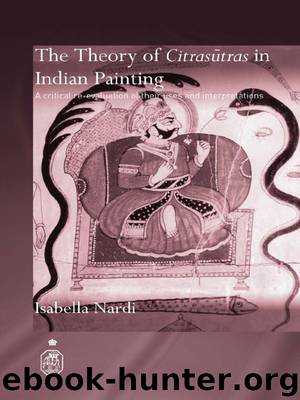The Theory of Citrasutras in Indian Painting by Nardi Isabella

Author:Nardi, Isabella
Language: eng
Format: epub
Publisher: Taylor & Francis (CAM)
Published: 2011-11-18T05:00:00+00:00
Figure 5.6 Yoga mudrā (Rao 1914, plate V, fig.17).
Rao, Banerjea and Sthapati enumerate a number of other mudrās to be added to those of the Vāstusūtra Upaniṣad, but unfortunately they omit to mention the textual sources used. Among them are for example añjali mudrā, which is also mentioned by the Devatāmūrtiprakaraṇa and Nāṭya Śāstra, and kaṭaka mudrā, which presents some significant problems of interpretation.
In the añjali (honouring) mudrā the palms of the hands are kept close to each other and the folded hands are made to rest on the chest. This hand pose is indicative of worship and prayer (Rao 1914, p. 16) and even today in Indian society making this gesture denotes respect. According to the Devatāmūrtiprakaraṇa (5.67) the image of Garuḍa has two hands in the añjali position. The Nāṭya Śāstra (9.127–128) explains this posture saying that it is composed by two patāka (banner) hands put together. It further enjoins that in regard to the deities añjali is held on the head, to venerable persons near one’s face, and in greeting friends añjali is placed on the breast.
The explanation of kaṭaka (string) mudrā presents some discrepancies between secondary literature and the texts. Rao (1914) and Banerjea (1941) sustain that kaṭaka or siṃhakarṃa (lion’s ear) mudrā (Figures 5.7 and 5.8) is the pose of the hand in which the tips of the fingers are loosely applied to the thumb so as to form a ring or to resemble a lion’s ear. Rao (1914, p. 15) maintains that the hands of goddesses are generally fashioned in this manner for the purpose of inserting a flower in them. On the other hand, Sthapati (2002, p. 85) explains that the name kaṭaka derives from the position of the hand that resembles a crab. It is worth noting that the descriptions of this mudrā are different from what is stated in the Nāṭya Śāstra and Samarāṅgaṇa Sūtradhāra. In particular, if we follow the suggestion of Sthapati that this mudrā resembles a crab then we should look at karkaṭa (crab or Cancer) mudrā of the texts and consider kaṭaka as a misspelling for karkaṭa. This, however, is not solely a problem of terminology; the position of the hands is also different. According to the descriptions provided by the secondary literature, it appears that only one hand is used, whereas in the Nāṭya Śāstra this position is one of the saṃyuta or combined mudrās. The Nāṭya Śāstra (9.132–133) explains that in this gesture the fingers are interlocked resembling a karkaṭa (crab). The text adds that this position is used to represent either yawning, supporting the chin or holding a conch-shell in order to blow it. In the Nāṭya Śāstra there is also another mudrā with a similar name, but also in this case it does not seem to correspond to the kaṭaka mudrā identified in the secondary literature. This mudrā is named kaṭaka mukha mudrā. The Nāṭya Śāstra (9.60–63) clarifies that this gesture is a non-combined mudrā in which the forefinger is kept curved and pressed down by the thumb, and the ring finger and the little finger are raised and bent.
Download
This site does not store any files on its server. We only index and link to content provided by other sites. Please contact the content providers to delete copyright contents if any and email us, we'll remove relevant links or contents immediately.
Aircraft Design of WWII: A Sketchbook by Lockheed Aircraft Corporation(31767)
The Great Music City by Andrea Baker(21195)
Call Me by Your Name by André Aciman(18953)
The Art of Boudoir Photography: How to Create Stunning Photographs of Women by Christa Meola(17834)
Shoot Sexy by Ryan Armbrust(17133)
Plagued by Fire by Paul Hendrickson(16630)
The Secret History by Donna Tartt(16608)
Portrait Mastery in Black & White: Learn the Signature Style of a Legendary Photographer by Tim Kelly(16478)
Adobe Camera Raw For Digital Photographers Only by Rob Sheppard(16380)
Photographically Speaking: A Deeper Look at Creating Stronger Images (Eva Spring's Library) by David duChemin(16151)
Bombshells: Glamour Girls of a Lifetime by Sullivan Steve(13100)
Pimp by Iceberg Slim(12922)
Ready Player One by Cline Ernest(12828)
The Goal (Off-Campus #4) by Elle Kennedy(12424)
Art Nude Photography Explained: How to Photograph and Understand Great Art Nude Images by Simon Walden(12339)
Kathy Andrews Collection by Kathy Andrews(10506)
Thirteen Reasons Why by Jay Asher(7782)
Wonder by R.J. Palacio(7723)
Goodbye, Things by Fumio Sasaki(7719)
